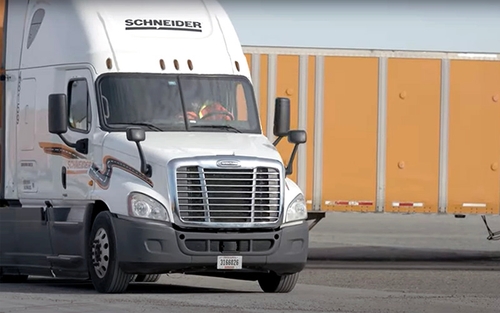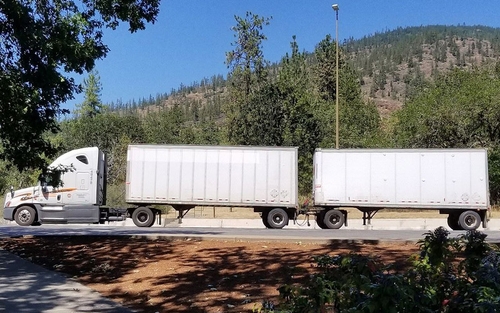How many hours can a truck driver drive? HOS rules explained


By The Schneider Guy
Estimated reading time: 4 minutes
Commercial truck drivers involved in interstate commerce must adhere to federal Hours of Service (HOS) regulations. These regulations include:
- The maximum amount of time a driver can work.
- The minimum amount of time a driver must rest before returning to work.
The regulations can be confusing, so drivers often need time to fully understand the ins and outs of HOS rules. That’s why many drivers ask, “How many hours can a truck driver drive?”
How many hours can a truck driver drive?
A truck driver can drive for up to 11 hours within a 14-hour on-duty window, after which they must rest for 10 consecutive hours.
During the 11-hour timeframe, drivers must take a break, as well as follow all logging requirements and other HOS rules.
Hours of Service rules for truck drivers
HOS rules were established to protect the safety of professional drivers and the motoring public.
Drivers who violate HOS rules may be placed out of service and fined for a regulation violation. It can also negatively impact a driver’s and carrier’s Compliance, Safety and Accountability (CSA) score. Depending on the severity of the violation, drivers and carriers may also face civil penalties.
There are five main HOS rules all truck drivers should be aware of:
1. The 11-hour rule.
Drivers cannot drive more than 11 hours following their 10 hours of off-duty time.
2. The 14-hour rule.
Drivers have a 14-hour window to drive a maximum of 11 hours. They are required to take a 30-minute break after eight hours of driving.
With this rule, drivers cannot drive after reaching the 14th consecutive hour following 10 hours of off-duty time, regardless of the composition of those 14 hours.
3. The 10-hour break.
The 10-hour break is defined as 10 consecutive hours in an off-duty status. This can be:
- 10 consecutive hours in the sleeper berth.
- 10 consecutive hours of “off-duty” time.
- A combination of sleeper berth and off duty for 10 consecutive hours.
4. The 60/70-hour limit.
Drivers cannot continue driving after they’ve reached:
- 60 hours on duty in a seven-day period.
- Or, 70 hours on duty in an eight-day period.
5. The 34-hour restart.
A 34-hour restart allows drivers to reset their 60-hour or 70-hour clocks to zero.
Drivers can take advantage of the rule at any time by taking at least 34 consecutive hours off duty or in a sleeper berth.
Duty statuses for truck drivers
Truck drivers are required to log their off-duty, sleeper berth, driving and on-duty hours – each recorded as a different status.
Most electronic logs capture driving time automatically. However, truck drivers are responsible for accurately recording their non-driving time.
Log statuses include:
1. Off duty (Line 1).
Includes all time a driver is not driving or performing other job-related duties. During this time, the driver is not required to be ready to work and can do other activities, such as:
- Eat a meal.
- Exercise.
- Spend time at home.
- Relax at a truck stop.
2. Sleeper berth (Line 2).
Includes all time a driver spends in their sleeper berth.
3. Driving (Line 3).
Includes all time a driver spends at the controls of a commercial motor vehicle (CMV) in operation.
4. On duty not driving (Line 4).
Includes the time a driver is doing non-driving work or is ready to work, until they are relieved from work. It includes tasks like:
- Loading/unloading freight.
- Completing pre-trip inspections.
- Training other drivers.
- Fueling a truck.
HOS exceptions for truck drivers
HOS regulations apply to most CDL drivers. But, like most rules, there are some expectations.
It’s up to every driver to understand what, if any, expectations apply to their role. Some of the more common exceptions include:
1. Team drivers.
Team drivers can spend up to two hours of off-duty time in the passenger seat while their teammate drives.
2. Personal conveyance.
Personal conveyance involves using a truck for personal transportation.
3. Yard moves.
Driving done in a limited-access lot or yard can be performed in an on-duty not driving status.
4. Short-haul exemption.
CDL drivers who consistently operate within a 150 air-mile radius and begin and return to their terminal within 14 hours may be exempt from keeping logs. These drivers may report daily hours instead.
5. Adverse driving conditions.
Drivers may extend their maximum driving and maximum workday limits by up to two hours when operating in certain driving conditions.
The FMCSA defines these as conditions that could not have been known at the start of the driver’s workday, including:
- Snow.
- Sleet.
- Fog.
- Highway covered with snow or ice.
- Unusual road and traffic conditions.
6. Direct emergency assistance.
Drivers may complete their assignment, even if they will exceed their HOS limits, under certain emergency conditions, such as a federal or state emergency declaration.
Wondering where truck drivers sleep?

Schneider Guy loves the "Big Orange." He's passionate about the trucking industry and connecting people to rewarding careers within it. He's been the eyes and ears of our company since our founding in 1935, and he's excited to interact with prospective and current Schneider associates through "A Slice of Orange."



